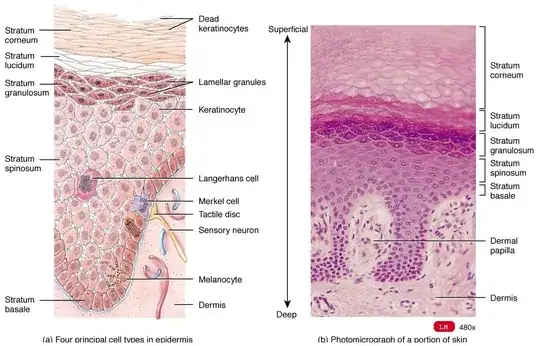The easy answer is that skin turns over, and rather quickly at that. Specialized skin cells called melanocytes impart more or less melanin (through granules called melanosomes) to keratinocytes; these cells then are what give you a tan. The keratinocytes undergo constant turnover, so are eventually shed, and in the absence of continued exposure to UV radiation, there is no need to keep producing melanin-heavy keratinocytes. (It's a bit more complicated, but that's the basic idea.)

The keratins and proteins within the stratum corneum act mainly by scattering and absorbing the UV. UV-R sets in action an integrated mechanism for the formation and delivery of melanin within melanosomes from melanocytes to keratinocytes. This mechanism is probably triggered by keratinocytes, which respond to UV-R with bursts of mitoses and with increased production of ET-1 and POMC, thus creating a new demand for melanosomes. The mitotic rate of basal keratinocytes increases a day after UV exposure, reaches a maximum 2 days later, and maintains this level for ∼1 wk. It then declines, and the skin regains its original thickness after 1–2 months if there has been no subsequent exposure.
In other words, for a light-skinned individual, light skin is normal, healthy, and appropriate. A tan represents response to a level of damage. When the damage ceases, the skin stops producing the unnecessary cells and the unnecessary pigmentation.
Is there is any medical disadvantage of a high melanin level during periods of reduced sun exposure[?]
Yes. Darker skin is less conducive to production of Vitamin D. This is why Southern Asians living in northern European cities are more prone to Vitamin D deficiency.
Also, when exposed to UV radiation, melanin can itself become somewhat toxic to cells, the photosensitization generating superoxide radicals which can injure individual cells. So the risk having melanin must be outweighed by the protective effect of melanin against UV light. It's a delicate balance.
Continued exposure to UV light stimulates the melanocytes to grow. This increases the chance of the development of melanomas. Since skin cells containing melanin are shed (there's no getting around that), in light-skinned individuals, keeping a tan is to keep injuring the skin and risking carcinogenesis.
Melanin Pigmentation in Mammalian Skin and Its Hormonal Regulation
Human skin pigmentation: melanocytes modulate skin color in response to stress
Mechanism of UV-related carcinogenesis and its contribution to nevi/melanoma
